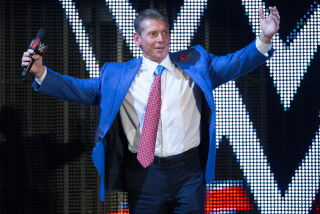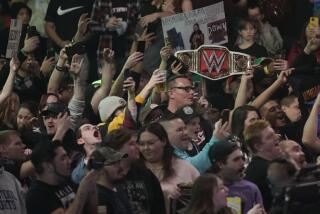WWE’s flip side
- Share via
Wrestling impresario Vince McMahon will never be confused with Mr. Rogers, but he sure wants to be. The chairman of World Wrestling Entertainment Inc. doesn’t even like the word “wrestler” anymore. He prefers “performer” or “superstar” or “diva” to describe his stable of talent.
Gone is much of the sexual innuendo, over-the-top trash talk, blood-splattering bouts and scantily clad female wrestlers that fueled the WWE’s “Attitude Era” of 10 years ago when the company was locked in a death match with Ted Turner’s rival wrestling outfit, World Championship Wrestling, which McMahon eventually bought out.
Now McMahon, 64, is hawking a kinder, gentler, wrestling show, and that new approach was on display this past weekend when WWE took over L.A. Live as part of a massive promotional push. The effort culminated with SummerSlam, a sold-out pay-per-view telecast at Staples Center on Sunday night, which was also expected to generate roughly 500,000 purchases across the country.
About 7,000 people stood in long lines under the hot sun Saturday and Sunday to get the autographs of WWE stars and watch exhibition matches during SummerSlam Axxess, which is basically fan appreciation day. Some drove for hours to be there -- Yolanda Barajas came down from San Francisco with her two kids for the weekend because they are such huge fans.
“They don’t play video games, they just watch this,” she said of her young sons.
On the lookout for recruits was the Army National Guard, one of the WWE’s big sponsors, which offered up an obstacle ropes course and a rock-climbing wall.
Children filled Staples Center on Sunday night, lining up in the aisles with portable cameras and hands held out just hoping a passing wrestler would acknowledge them. Crowd anticipation for the pay-per-view event was so high there were literally cheers when the warning about illegal recordings of the program appeared on the big screen; it was a sign that the festivities were about to begin.
Hardy Warren of Agoura Hills brought his 10-year-old, Zachary, to SummerSlam over the objections of his wife.
“Seeing it on TV it seems harmless enough,” he said over the noise of the crowd, which was being pumped by AC/DC’s “Shoot to Thrill” blasting over the sound system. “If it isn’t kid-friendly, you won’t sustain me. This has to be along the lines of superhero cartoons.”
Warren is precisely the kind of paying customer McMahon is eager to satisfy. With mixed martial arts and ultimate fighting attracting an older and rougher crowd, WWE is taking aim at kids and families to shore up its bottom line. While the occasional chair might still get thrown, the violence is “very Wile E. Coyote-ish,” according to Hunter Hearst Helmsley, better known to wrestling fans as Triple H.
(Playing up the family ties, Helmsley happens to be married to McMahon’s daughter Stephanie, a WWE executive.)
“It’s less of ‘The Jerry Springer Show’ now,” added John Cena, arguably the WWE’s biggest star, who takes some of the credit for pushing McMahon to make the entertainment less edgy.
Other events might have pushed him in that direction as well. In 2007, wrestler Chris Benoit killed his wife and son and then himself, an incident that cast a dark cloud over wrestling and pushed the WWE to further toughen its existing drug-testing policies.
“That has a lot to do with how WWE operates now,” said Cena. Another wrestler, Ted DiBiase Jr., said it is not uncommon to be tested more than once a month.
The wrestling attire for the ladies has become more conservative as well. Maria Kanellis, one of the WWE’s “diva” wrestlers, used to perform in lingerie but these days tries to dress “a little more sophisticated” for her matches.
“The guys miss it, but that’s how it goes,” she said.
Her costumes now consist of leggings, lots of “fringe outfits and things that are sparkly.” It’s not unusual, she said, for some of the girls to get reprimanded for “showing too much cleavage,” something that would’ve never happened a few years ago.
This new direction has generated a certain measure of controversy. YouTube is filled with videos from hard-core fans ripping the softer WWE, and there is no shortage of arguments about the subject in Internet chat rooms. “You can’t please everybody,” Cena said, adding, “Our business was down and the product was becoming old and stale.”
But the strategy has proven effective. After McMahon toned down the content, he went to his network partners and asked them to reconsider the ratings assigned to the show. WWE’s programming, scattered across cable networks USA and SyFy, superstation WGN and broadcast television’s MyNetworkTV, was usually given a TV-14 rating, the small-screen version of the MPAA’s R-rating and a surefire red flag to parents and advertisers.
The milder programming, which now usually garners a TV-PG rating from WWE’s TV partners, has cleared the way for more blue-chip advertisers to come aboard, including Pepsico, AT&T; and Procter & Gamble.
“People have misunderstood our product,” McMahon said, adding that the ratings change “allowed people to take another look at us, and it has broadened our horizons with sponsors,” McMahon said.
The audience has grown too. In the second quarter, WWE’s television programs averaged 16 million viewers, a 10% improvement from the same period a year ago. Of that audience, 36% are women. WWE also has a strong Latino following that accounts for 23% of its audience.
The WWE’s next move is to launch a cable network, which McMahon hopes to get off the ground within two years. While that objective is challenging in today’s economic environment, WWE programming does well, and there is a vast library of content to fill the void between new shows (in addition to wrestling, WWE also operates a small movie studio, video games and a record label). Plus the success of McMahon’s pay-per-view events has him feeling pretty confident.
“We have a lot of clout,” he said.
That clout extends to the WWE family of wrestlers as well, most of whom don’t have outside representation. In many ways, McMahon runs WWE like an old-time studio boss. While talent can and sometimes does leave the fold, most have an almost unfailing loyalty toward McMahon.
“Vince will take care of you,” said Paul Wight, a 14-year WWE veteran whose stage name is “Big Show.”
“I’m not a real fan of agents,” acknowledged McMahon. “As long as you are fair with everyone, why would you have an agent?” he wondered, adding that his top guys pull in “several million dollars a year.” The WWE, however, is represented by the recently formed WME Entertainment, whose chief, Ari Emanuel, was in attendance Sunday night with his son, Noah.
Interestingly enough, the changes McMahon has instituted aren’t just limited to on-screen antics. DiBiase said the rock ‘n’ roll lifestyle of many wrestlers off camera is also history -- no more late-night partying and groupies.
“We’d rather go back to our hotels and play Nintendo,” he said.
--
More to Read
Go beyond the scoreboard
Get the latest on L.A.'s teams in the daily Sports Report newsletter.
You may occasionally receive promotional content from the Los Angeles Times.











